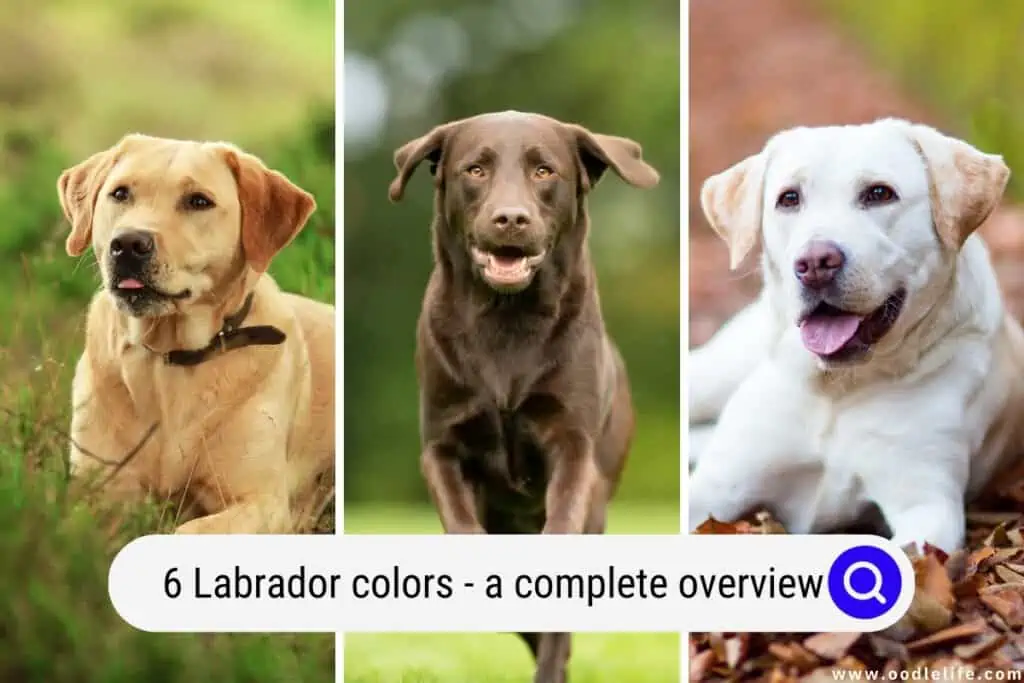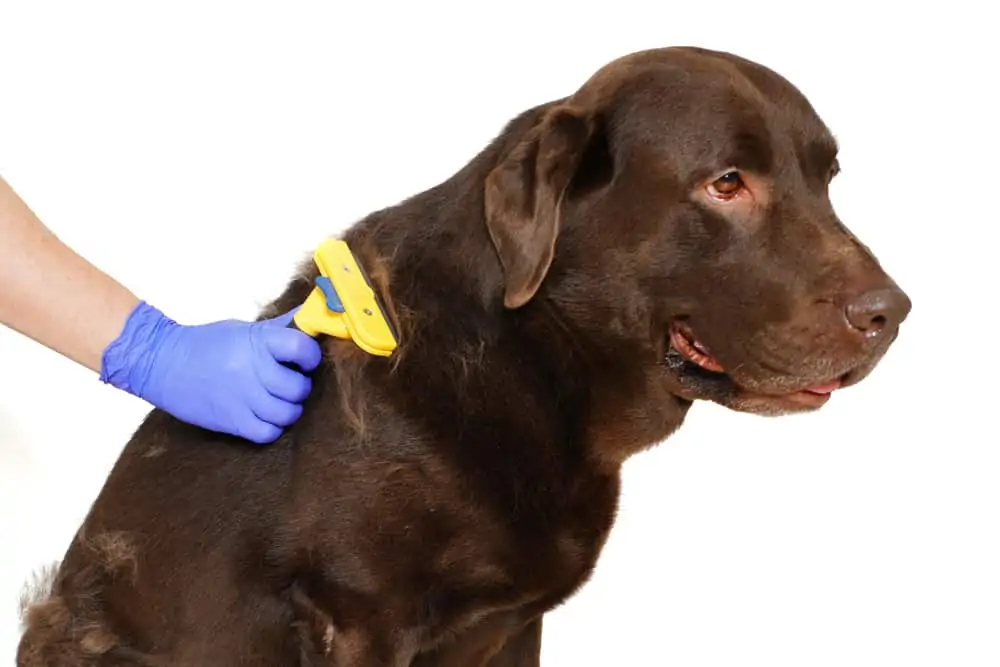6 Labrador Colors: A Complete Overview (With Pictures and Rare Colors)
Labradors make excellent first pets for kids and great companions to anyone who wants a loyal, cuddle-loving dog.
Since it’s hard to beat a Labrador’s friendly personality, one of the biggest decisions people often encounter when choosing this breed is picking their preferred color.

Traditionally, Labrador colors come in three varieties. But several other color variations exist, and I’ll help you understand their background and genetics.
6 Primary Labrador Colors
The Kennel Clubs only recognizes three colors in Labs: chocolate, black, and yellow. However, you can encounter several other Labrador colors thanks to genetic variation and different breeding practices.
Below are six of the most common color varieties.
1. Black Labrador
Since four out of nine potential Labrador color gene variations result in a black coat, black Labs are the most common coat color in Labradors. Their gene variations are as follows:
- EEBB
- EEBb
- EeBB
- EeBb
If you haven’t brushed up on genetics from your high school science class, that likely looks like a lot of confusing letters. So, the takeaway here is that black Labs are always the dominant coat color.
People love black Labs for their soft, shiny coats. Dirt doesn’t show up much on them, so you can take them on a hike in the woods without worrying about staining their fur.

2. Yellow Labrador
Yellow Labs come in as the second most common color after black Labradors. Unlike black Labs, which have an unmistakable, predictable color, yellow Labs can come in many different shades.
In fact, the coat colors can vary so much that I’ll soon give you examples of two less common Lab colors that, from a genetic perspective, are variations of the yellow Lab.
The genetic makeup of yellow Labradors includes one-third of the possible Lab color combinations. The genetic codes include eeBB, eeBb, and eebb.

3. Chocolate Labrador
Chocolate Labs are the rarest of the three primary Labrador colors. There are only two genes that will produce these dogs—EEbb and Eebb.
As with yellow Labs, chocolate labs vary significantly in their coat color. Some chocolate labs have a light brown coat, others a medium brown, and some are even so dark that they appear mixed with black and brown.
Sadly, chocolate Labradors don’t live as long as black and yellow Labs. Aside from their genetic predisposition to an earlier death, these dogs can also suffer from the same issues as other Labs, including patellar luxation, osteochondritis dissecans, and canine hip dysplasia.
So, if you have your heart set on buying a chocolate Lab, keep in mind that you may lose your best four-legged friend about 1.5 years sooner than if you were to bring home a black or yellow Lab.

4. Red Fox Labrador
If this is your first time hearing the name “red fox Labrador,” you’re not alone. These dogs, which also simply go by the name “red Lab,” are technically yellow Labradors.
They get their dark, reddish coat from the same gene as yellow Labs. But since yellow Lab genes can present a wide variation in yellow colors, it causes some puppies to enter the world with an almost red coat.
The great part about red fox Labradors is that since breeders claim they have the same genetic makeup as yellow Labs, you won’t have to worry about them having additional health issues or dying younger than average.

5. Silver Labrador
You might have trouble recognizing a silver Lab as a Labrador when they walk by, given that this is such a distinct color deviating from the three primary colors.
And, unfortunately for silver Labs, these dogs are a color variation from chocolate Labs. So, they may share the same genes as chocolate Labradors, meaning they’ll suffer from more health issues and have a higher chance of dying younger compared to the other Labrador colors on this list.
Another issue that silver Labs frequently face is color dilution alopecia. Alopecia is a condition when the immune system harms hair follicles, which leads to skin issues and hair loss.
So, should you be interested in breeding your Labrador, please be responsible and never breed a silver Lab.

6. White Labrador
If you guessed that the white Labrador originates from the yellow Lab, you’re spot on. Like red fox Labradors, white Labs have the same genetic makeup as yellow Labs.
However, white Labs have such little yellow pigment in their fur that it appears they’re almost white. Nevertheless, no one will mistake these dogs for pure white; they almost always retain a light cream-colored look, thanks to some yellow fur.
It’s also common for white Labs to have darker cream or brown accents on their ears and paws, which is where extra yellow fur congregates.
It’s important to note that white Labs aren’t the same as albino Labradors. Albinism is a life-threatening and rare genetic condition resulting from a lack of pigmentation. Albino Labs often die young and suffer from conditions like blindness and deafness.

Can Labradors Be Different Colors Than Their Parents?
If you think mating two black Labradors is a guarantee for producing black Lab puppies, think again. Black is a dominant gene in Labs, but the color yellow always overrides black and chocolate.
I won’t bore you with the details by writing it all out. Instead, check out the chart below to see the puppy colors from mating different colored Lab parents.
| Parent Colors | Black Puppies | Chocolate Puppies | Yellow Puppies |
| Black + Black | Yes | Yes | Yes |
| Black + Yellow | Yes | Yes | Yes |
| Black + Chocolate | Yes | Yes | Yes |
| Chocolate + Chocolate | No | Yes | Yes |
| Chocolate + Yellow | Yes | Yes | Yes |
| Yellow + Yellow | No | No | Yes |
If you’re interested in genetics, studying how Labrador colors happen will fascinate you. But some takeaways are that the colors aren’t dependent on the sex of the dog, and the colors black and chocolate are variations of the same gene.

Is It Possible To Predict Labrador Puppy Colors?
If you know the genetic background of the parents, then it’s possible to predict what colors their puppies could be.
However, unless you’re breeding two yellow Labs, there’s no way to guarantee the colors. Plus, you must remember that the parent’s colors aren’t the only determining factor; if their parents had different color genetic makeups, it could impact the current litter’s colors.
That’s because although it’s technically possible for certain dog combinations to have two or three of the standard Labrador color varieties, they could bear puppies that all have the same color or only two of the three colors.

Do Different Colored Labs Behave Differently?
Black Labradors have a reputation for being the calmest and most loving of the Lab colors. Meanwhile, people say that yellow Labs are the friendliest and chocolate Labs have the most energy.
But here’s the thing: There isn’t scientific proof of this, and some of the praise for black Labs could be because there are more black Labs in the world than any other Lab color.
I’d be remiss not to point out that many service dog organizations don’t actively use chocolate Labs in their training. However, the reason for this is likely a combination of chocolate Labradors being a rarer genetic coloring and them only living 10.7 years on average compared to a yellow and black Lab’s 12-year average lifespan.
So, while Labradors will develop individual personalities, it’s akin to how humans have their personal quirks. As of right now, the science says that coat color has nothing to do with it.

The Bottom Line
Although Labradors come in many different colors, they all have a genetic predisposition to be excellent family dogs, friendly with strangers, and loyal.
Of the different Labrador colors, black is the most common since it’s a dominant gene. Therefore, if you have your heart set on purchasing a Lab of a different color, they may cost more money.